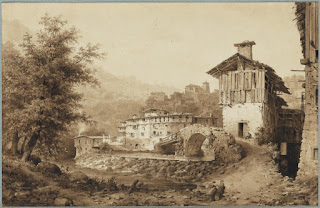Every Year In Film #3 - Passage Of Venus
Quick Thoughts: Passage Of Venus (1874)
The captured transit of Venus across the Sun.
Passage Of Venus is an astounding 'film' and one of the oldest surviving cataloged movies. Made by Pierre Jules César Janssen, this tracks the incredibly rare transit of Venus--the second planet from the Sun, hottest in the Solar System. To demonstrate how rare this movement across the Sun is, the last was in 2012, the one before that, 2004 - and the one before that 1882.
To add further perspective, the next passage will occur 100 years from now in 2117. That said, this film captures the transit that occurred 8 years before the last of the 19th century in 1874, and knowing this when you watch the few second clip is pretty awe-inspiring.
As implied, this isn't really a film, rather it is a set of photographs shot with a 'photographic revolver':
This is a device that was developed by Janssen to take multiple photographs at controlled intervals; 48 exposures in 72 seconds.
Janssen himself was an astronomer and professor of general sciences in the University Of Paris from 1865 onward who is credited with the discovery of helium. His research in astronomy and the rare opportunity to research and catalog the transit of Venus lead him to travel to Japan in 1874 to capture this film.
The photographic revolver functions with clockwork technology to turn metal photographic plates:
The type of photography is know as daguerreotypy and was the first publicly available kind of photography. Louis-Jacques-Mandé Daguerre was a French painter and photographer...
... who invented this process in 1839. Daguerreotypy functions with silver-platted copper sheets that are treated with many chemicals before and after being exposed to light. Whilst this process was lost in the latter half of the 19th century to bettering technology, it has been reprised recently, and an example of this can be seen is this beautifully shot short documentary by Patrick Richardson Wright that illustrates the process of daguerreotypy much better than I could:
Passage Of Venus is an astounding 'film' and one of the oldest surviving cataloged movies. Made by Pierre Jules César Janssen, this tracks the incredibly rare transit of Venus--the second planet from the Sun, hottest in the Solar System. To demonstrate how rare this movement across the Sun is, the last was in 2012, the one before that, 2004 - and the one before that 1882.
2012 Transit of Venus
As implied, this isn't really a film, rather it is a set of photographs shot with a 'photographic revolver':
This is a device that was developed by Janssen to take multiple photographs at controlled intervals; 48 exposures in 72 seconds.
Janssen himself was an astronomer and professor of general sciences in the University Of Paris from 1865 onward who is credited with the discovery of helium. His research in astronomy and the rare opportunity to research and catalog the transit of Venus lead him to travel to Japan in 1874 to capture this film.
The photographic revolver functions with clockwork technology to turn metal photographic plates:
The type of photography is know as daguerreotypy and was the first publicly available kind of photography. Louis-Jacques-Mandé Daguerre was a French painter and photographer...
... who invented this process in 1839. Daguerreotypy functions with silver-platted copper sheets that are treated with many chemicals before and after being exposed to light. Whilst this process was lost in the latter half of the 19th century to bettering technology, it has been reprised recently, and an example of this can be seen is this beautifully shot short documentary by Patrick Richardson Wright that illustrates the process of daguerreotypy much better than I could:
Janssen modified the early forms of this technology in the 1870s, developing upon previous British incarnations of the photographic revolver to a standard that would allow him to capture the transit at high quality. As can be seen by looking again at this image...
... the polished plate would be placed in a circular container and spun, in a controlled manner by clockwork, so that frames would be printed around the face. This is somewhat reminiscent of the kind of imagery we explored in the previous post of the series on Stroboscopes, Phenakistoscopes and Zoetropes:
By taking continuous photographs with his developed technology, Janssen was then making significant strides away from what we can define to be a pre-cinematic form of animation. In such, instead of relying on cartoons to be the tool of moving imagery, Janssen allowed the possibility of continuous photography captured from the real world to be manipulated into motion.
And such marks the significance of this remarkable film that I'll conclude by leaving you to watch...
< Previous post of the series Next >
Previous post:
The Handmaiden - Novel Black Comedy
Next post:
The Patience Stone - Extreme Genuity
More from me:
amazon.com/author/danielslack

















